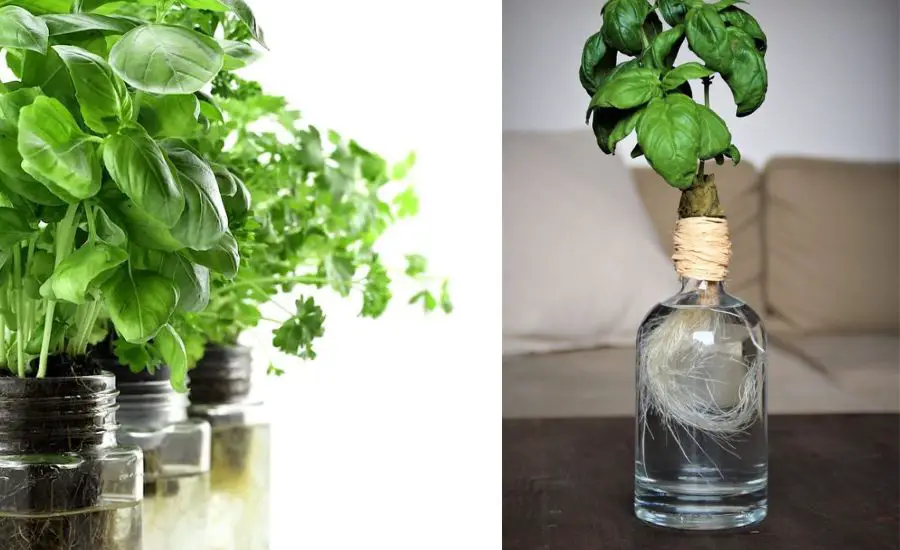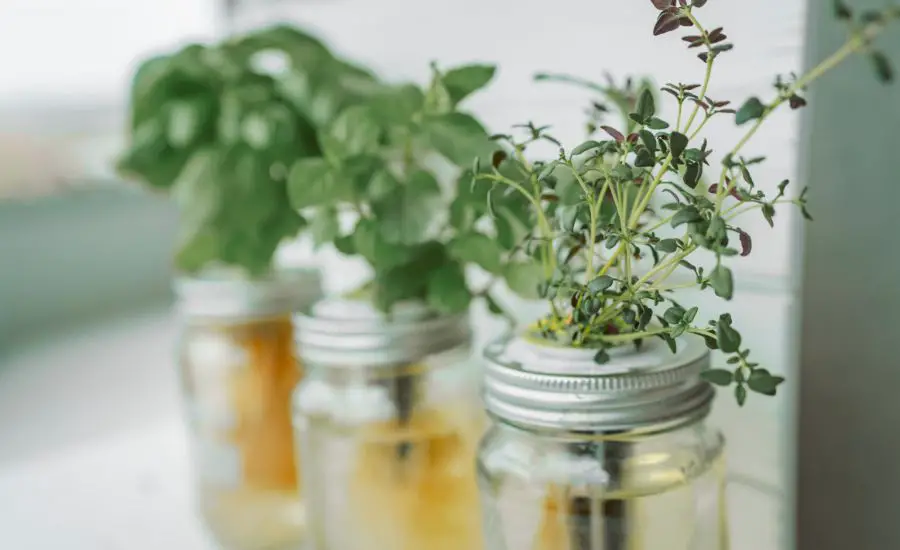The Kratky method, a version of deep water culture hydroponics, is gaining popularity and means growing cultures without soil.
The Kratky system is easy to make. Once you’ve made Kratky hydroponics, you can forget about it till it’s time to gather the harvest.
Kratky hydroponics system doesn’t need big and expensive equipment, electric water pumps, much space to locate, or much time to spend. The passive method of hydroponic growing is simple even for beginners and perfect for fast and successful crop harvesting.

Contents
What can you grow with the Kratky method?
You can grow all leafy greens and a lot of fruiting plants using the Kratky method but there are some nuances. So, let’s take a closer look at the features of the hydroponic growing of various plants. We can divide the plants into 3 categories.
Plants that are best grown using the Kratky method
This category includes different types of lettuce (Looseleaf, Little Ceasar, Coral, Ruby, Crishead), leafy greens (Spinach, Bok Choi, Kale, Arugula, Fennel), and herbs (Sweet basil, Lemon basil, Parsley, Dill, Dill Cilantro, Mint, Sage).
These plants are better to grow using the Kratky system because they are small plants with a short life cycle but a fast growth rate that doesn’t produce fruit.
This means that they have time to mature before the need to refill water or nutrient solution. But at the same time, it’s not enough for fungal, bacteria, or algae growth inside the tank.
You may be surprised but having such a reservoir on your windowsill, you’ll be able to harvest more than once. As soon as the first leaves reach the desired size, cut them and wait for the next ones. Thus, over some time, you’ll always have fresh leaf crops.

What else plants it is possible to grow using the Kratky method?
The next category of plants that we will consider can be grown using the Kratky method. But there are certain difficulties and certain features that must be paid attention to before finally deciding on growing them at home.
We mean large and long plants that first flower and later produce fruit. Larger plants use a lot of water, and it means that the container you are going to grow them should be bigger than that to grow leaf crops.
Besides, it is hard to deal with flowing and fruiting plants while growing them by the Kratky method as they require different hydroponic nutrients during different lifecycle stages – one hydroponic fertilizer will be best for early leaves, and the other one for the blooming period. So, it’s difficult to control the nutrient level during a plant’s lifecycle.
But despite these difficulties, you can grow such plants. Let’s get acquainted with the details of growing each one.

Tomatoes
If you are going to grow tomatoes, think about a large container first. The bigger the plant is, the larger the container it is needed.
You can’t grow tomatoes in a mason jar. Usually, the larger the plant, the thicker the stems it has, the more water it drinks, and the larger the tank you need.
Moreover, you’d be careful and watch thoroughly the essential nutrients, pH level, and temperature.
Solution: Choose small tomato plant varieties like cherry tomatoes and grow them indoors. They don’t drink as much water as larger tomato plants and they suit great on your kitchen windowsill.
Cucumbers
When growing cucumbers, you can face analogical problems as when growing tomatoes. Cucumbers are also considered to be large plants that need a lot of water.
Plus, since cucumbers are entwined, you’ll have to install vertical support or trellis and tie the plant so that it grows well and gives a good harvest.
Other plants
The same situation with other different plants. They are all large, and take a long time to produce and mature fruits.
Brussels sprouts, peppers, corn, beans, eggplants, zucchini, pumpkins, and melons will require constant refills of water and nutrient solution as they quickly become depleted, and long or sprawling plants grow and overwhelm the area too fast.

Can you grow strawberries with the Kratky method?
Yes, you can grow strawberries using a Kratky system.
The plant grows well when supplied with plenty of water, so take care of a larger container than you usually use to grow fast-growing plants like spinach and other leafy greens.
Besides, it’s a great opportunity to get many new strawberry plants for rapid reproduction by rooting the runners.
When a strawberry plant grows to a definite point, it produces a few side runners called tendrils that grow horizontally away from the plant.
When tendrils touch down into the soil, they set roots, and another strawberry plant starts growing.
So, take those tendrils, plant them into new net cups, and wait for the appearance of the roots. Then cut the tendril off from the original plant and you’ll have one more strawberry plant.
What are 3 things that we can’t grow hydroponically?
You can’t grow a slower-growing or larger crop with this method, or, root crops that belong to the third category. As they grow for several months, you’ll have to spend more time and effort to grow root vegetables. You’d always keep a proper water level, refill nutrients, and prevent microorganism overgrowth.
To be true, you’ll lose all the conveniences of passive hydroponics growing thanks to which it is considered so excellent.
What plants are impossible to grow using Kratky hydroponics? These are Carrots, Potatoes, Turnips, Beets, Sweet potatoes, Parsnips, etc.
As you can see, there are not 3 of them but much more. And everything is because of the reason that root plants will be hanging in your reservoir. Thus, it requires effort to avoid excess moisture and root rot as a result.
Of course, you can try to grow for example potatoes using a Kratky method if you’ve already had a deal with the hydroponic growing method of small plants growing but it’s quite difficult.

Can you grow garlic and onions with the Kratky method?
Despite garlic and onions being root crops you won’t face the same problems.
Green onions, or scallions, are especially fruitful with the Kratky hydroponic. The green onion bulbs are small and they fit correctly inside the net pots. Put the net pots or cups into the drilled lids, ensure the roots touch the water, and wait for the result.
The same is for garlic.
Put a clove of garlic with its pointy side atop into a net cup and the root side should be down. Then place the cup into the tank and follow up the water touches the cup’s bottom.
What is the best-growing medium for Kratky method?
The Kratky hydroponic system is a non-circulating plant growing system. Therefore, after the initial installation of the devices, the introduction of water with nutrients, and the sowing of seeds or seedlings, you don’t have to do anything else.
It isn’t necessary to constantly add water, nutrient solution, install pumps or water and oxygen circulation systems. The plants grow on their own, and your task is to gather and enjoy a good harvest.
How to set up hydroponic systems? You can purchase a ready-made hydroponic system and fix it up by following these simple steps:
- Take a net pot, and fill it with an inert growing medium such as expanded clay, rockwool, coconut fiber, or sphagnum moss.
- Place the plant in a net pot and suspend it over a tank of water and nutrient solution so that only the tips of the plant’s roots touch the surface of the water.
- Harvest after 2-3 weeks or more, depending on the plant.

Home-built Kratky system
You can build Kratky hydroponics at home using at-hand devices.
- Take a container suitable for the number of plants you want to plant. A regular black bucket will also work. For a single plant, use a mason jar.
- Fill the container with high-quality water, distilled water, or tap water if it is of good quality and not contaminated.
- Add the hydroponic nutrients one by one, mixing well each time.
- Check the pH level of the nutrient solution using a pH meter. The correct pH level should range from 5.5 to 6.5. Adjust the pH level as needed with the pH Control Kit.
- Cover the tank with a lid, having previously cut or drilled holes in it for net pots.
- Place the net pot with the growing medium plant in the lid.
- Make sure that the roots hang freely in the air making the so-called “air gap” and only the tips of the roots touch the water. In this way, we provide not only a constant supply of water to plant roots but also enough oxygen.
Note: If you plan to grow plants in a homemade Kratky reservoir, then cover it to prevent much light. As a decision, wrap it in tin foil, or paint it preferably black.
The excess light will trigger the appearance and growth of algae, which will eat up the nutrients, and the grown plants will not have enough of them.

What are the advantages of the Kratky method?
Now you know everything about the Kratky method. But let’s summarize everything and review all the pros and cons of the Kratky passive system once again.
So, the Kratky method works great and even beginners can deal as it’s easy to set up and easy to use.
It’s cheaper than other hydroponic methods as it works without electronic devices and doesn’t require electricity to run.
Moreover, it’s really a passive system and you don’t have to put much effort into harvesting.
Finally, you can grow so many plants using the Kratky method, especially collard greens that will grow fast and give you fresh growing leafy greens for a lasting period.
What is the disadvantage of Kratky method?
The main disadvantage is that you can’t grow all types of plants equally effectively. Root vegetables and large plants with long mature periods it is better to grow with any other hydroponic method.
Besides, the Kratky method is great for home growing but not for cultivating food on a larger scale. For growing greens and vegetables in large quantities, for example for sale, other hydroponic systems will be more practical.

FAQs
Can I refill the Kratky reservoir?
Yes, you can if you see that the roots no longer touch the water level.
What nutrients are used in the Kratky method?
The most significant nutrients are nitrogen, phosphorus, and potassium. Not less vital are calcium, magnesium, and sulfur. Finally, your plants need iron, manganese, zinc, copper, boron, and molybdenum but to a lesser degree.
But you can buy a high-quality liquid nutrient mix to avoid problems with nutrient proportions.
Conclusion
Thus, the Kratky method is much better than similar hydroponic methods.
It’s gained popularity as it is analogous to Deep Water Culture hydroponics. But, if Deep Water Culture requires an air pump, air stone, and tubing, the Kratky method does not and that makes this method easier and cheaper.
In a Deep Water Culture system, the net pots and the whole root system are sunk in liquid. This means that the root system can’t get enough oxygen. So, an air stone and air pump do the job.
Avoid additional appliances, simplify your life, and grow food having a Kratky setup.
A garden is a place that relaxes us and reflects our personal style, it’s a place to spend time with loved ones and grow our own fruits and vegetables. Maybe you’re looking for design inspiration or plant selection, or you’re concerned about garden privacy, shady areas, or pests, but don’t worry, you’ve come to the right place.
